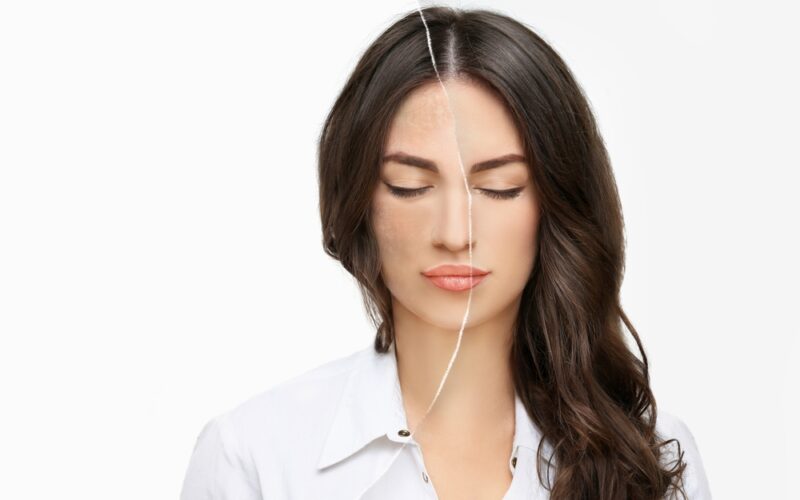Dark spots and uneven skin tone can be frustrating to treat. While hydroquinone has long been considered the gold standard for treating hyperpigmentation, several alternatives offer effective results with different benefits and limitations. Understanding hydroquinone vs other brightening agents can help you find the best solution for your specific needs.
Why There’s No One-Size-Fits-All for Hyperpigmentation
When treating dark spots and discoloration, several factors influence which brightening agent will work best for you. Skin type and sensitivity play crucial roles—what works beautifully for one person might trigger irritation for another. The type of hyperpigmentation matters too; melasma can be particularly stubborn often requiring a multi-faceted approach, while post-inflammatory hyperpigmentation might respond well to gentler options.
Severity and depth of discoloration affect treatment success, as superficial hyperpigmentation typically responds more quickly than deeper issues. Treatment duration considerations are important since some brighteners are safer for long-term use, while others like hydroquinone are generally recommended for limited periods. Your skin tone is another factor, as certain ingredients may pose higher risks for deeper skin tones. These variables explain why the hyperpigmentation treatment options that work for others might not be ideal for you.
How Hydroquinone Compares to Other Brightening Agents
Kojic Acid
When comparing kojic acid vs hydroquinone, kojic acid offers a natural alternative derived from fungi during fermentation. While not as potent as hydroquinone, it can effectively treat mild to moderate hyperpigmentation with results typically appearing after 1-2 months. It’s best for those seeking a natural option for sun spots and age spots. Some users may experience mild irritation, and products containing kojic acid may lose effectiveness when exposed to air and light.
Azelaic Acid
Azelaic acid vs hydroquinone reveals azelaic acid provides multiple benefits beyond brightening. This naturally occurring acid inhibits tyrosinase while offering anti-inflammatory and antimicrobial properties. It’s ideal for those with acne-prone skin or rosacea alongside hyperpigmentation and is one of the few brighteners considered safe during pregnancy. Prescription strength (15-20%) provides maximum efficacy, though over-the-counter options (10%) are also available.
Arbutin
Alpha-arbutin is a derivative of hydroquinone but gentler on the skin. It breaks down into hydroquinone at a slower, more controlled rate, showing moderate effectiveness with less irritation risk. Results typically appear after 1-2 months of use. This ingredient is ideal for those wanting hydroquinone’s benefits with reduced side effects, particularly for sensitive skin types. Product quality matters—look for formulations with 2-5% alpha-arbutin for optimal effectiveness.
Vitamin C
Vitamin C brightens skin by inhibiting tyrosinase and reducing oxidative stress. It offers moderate brightening effects with excellent preventative benefits against future hyperpigmentation while enhancing overall skin radiance. Best for preventing new dark spots and overall brightening, it works well when combined with other ingredients. For optimal results, look for stabilized formulations at concentrations between 10-20%, though sensitive skin may require lower percentages initially.
Niacinamide
Niacinamide (vitamin B3) brightens skin by interfering with melanin transfer from melanocytes to keratinocytes. This provides gentle but effective overall brightening, typically showing results within 4-8 weeks. Niacinamide is perfect for those seeking a gentle, long-term solution that also strengthens the skin barrier, regulates oil, and offers anti-inflammatory benefits. It’s considered safe for all skin types and during pregnancy, making it highly versatile. While it may not be potent enough for severe hyperpigmentation when used alone, it performs excellently as part of a comprehensive brightening regimen at concentrations between 2-10%.
Pros and Cons of Hydroquinone
In any skin brightening comparison, hydroquinone stands out for its efficacy. Its advantages include high effectiveness with visible results often within 4-6 weeks, strong clinical research backing, and availability in various strengths (2% over-the-counter, up to 4% prescription). It’s particularly effective for stubborn melasma and post-inflammatory hyperpigmentation, making it the go-to for severe discoloration.
However, hydroquinone has important limitations. It’s not recommended for long-term use (typically limited to 3-4 month cycles), may cause irritation and contact dermatitis, and poses a risk of ochronosis (blue-black discoloration) with prolonged use, particularly in deeper skin tones. It’s contraindicated during pregnancy or breastfeeding and has controversial regulatory status in some countries where it’s restricted or banned. After treatment cycles, maintenance with alternative ingredients is necessary to preserve results.
When to Choose an Alternative Over Hydroquinone
Consider alternatives to hydroquinone in several specific scenarios. During pregnancy or breastfeeding, ingredients like azelaic acid, vitamin C, and niacinamide are generally considered safer options due to hydroquinone’s potential for systemic absorption. For maintenance after completing a hydroquinone course, gentler agents like arbutin, kojic acid, or niacinamide can help maintain results without long-term hydroquinone risks.
If you have sensitive or reactive skin that has experienced irritation with hydroquinone, gentler options like niacinamide or low-concentration vitamin C may be better tolerated while still providing meaningful improvement. For long-term prevention strategies, vitamin C and niacinamide excel at preventing new pigmentation while supporting overall skin health.
When addressing minor discoloration or general uneven tone, gentler alternatives often provide sufficient results without hydroquinone’s potential side effects. Many dermatologists now recommend starting with these gentler options first, reserving hydroquinone for cases that don’t respond to initial treatment approaches.
Combining Brightening Agents Safely for Better Results
Combining compatible brightening agents can effectively target pigmentation from multiple angles. Effective combinations include hydroquinone with retinoids and mild corticosteroids (Kligman’s formula), vitamin C in the morning with niacinamide at night, azelaic acid with niacinamide, kojic acid with arbutin, and vitamin C with alpha hydroxy acids. When combining actives, start slowly with one product at a time, consider optimal timing for application, watch for irritation, seek professional guidance for a customized regimen, and always use daily SPF 30+ protection.
At Heally, our dermatology professionals can help create a personalized approach to treating hyperpigmentation based on your unique skin needs. Schedule a consultation today to explore your options.
Sources
NIH: Topical Hydroquinone for Hyperpigmentation: A Narrative Review
ScienceDirect: The Use of Botanical Extracts as Topical Skin-Lightening Agents for the Improvement of Skin Pigmentation Disorders
JAAD: 51716 Hydroquinone and Alternative Agents for Hyperpigmentation: A Systematic Review

